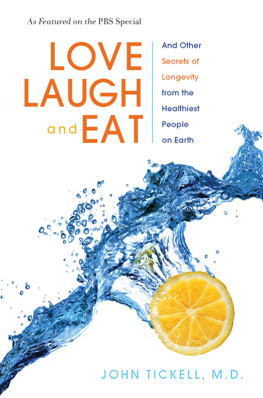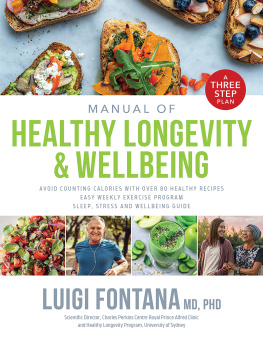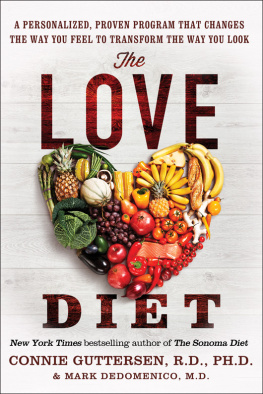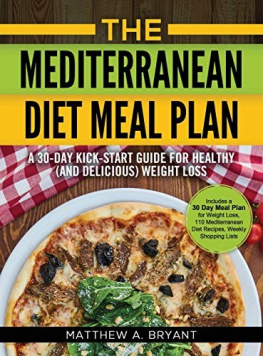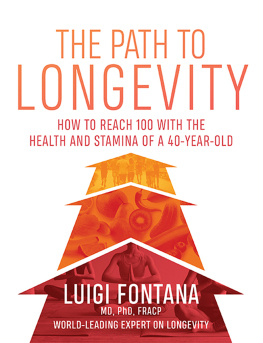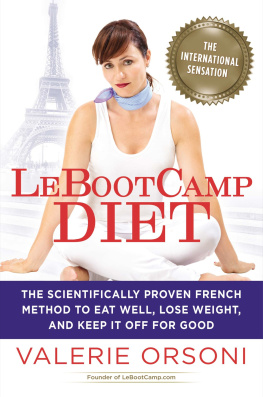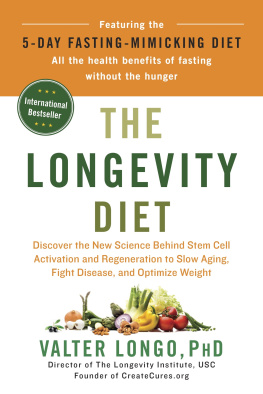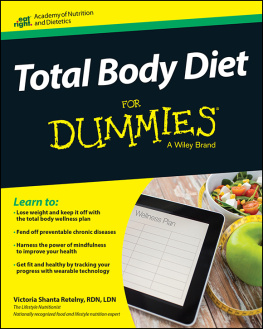
Thank you to my inspiration
the longest-living, healthiest people on earth
Thank you to Sue, the best wife,
the best mother, and my best friend in the world
Contents
T he world is full of specialists, technical experts, and people who love to complicate things. There is a minefield of misinformation out there that confuses us about how to cope with life. Exercising, eating, and getting our brains in gear have somehow become mysteries. Well, if I have any ability as a doctor, it is the ability to simplify complicated things.
Patients generally fall into two distinct groups: the single-cause patients and the multiple-cause patients. The former are those with an obvious medical or surgical emergencya bacterial infection, for instance, or an injury as a result of a trauma or accident, such as a broken bone. Something that good ol Doc can help. The latter group, however, consists of patients with severe lifestyle ailments and diseases, such as stress, anxiety and depression, most heart diseases, type 2 diabetes, cancer, and many other ailments. The causative and precipitating factors are multiplein most cases, researchers mumble about genetics and so onbut perhaps the real culprits are the lousy foods most of us eat, our inactivity, the environmental pollutants (including radiation) were subjected to, and how pressured, unhappy, and dissatisfied most of us are.
This shouldnt really come as a surprise. Were always busy, and our lives are filled with stresses and strains. On top of that, were all up against an enormous number of people and entities that dont care about our best health interests. You know who I mean; you know who Im talking about. Fast-food restaurants, for instance, and clever companies that sell us the latest healthy cookies and muffins and chips. Uninformed healthcare providers are in the mix tooand so many others.
Well, despite all this, Im here to teach you how you can love, laugh, and eat your way to the ripe old age of 100.
Youre probably saying to yourself right now, Hey, Doctor, thats impossible. But I want you to know that it is possible. My research over 25 years has shown me many people in their 60s, 70s, 80s, even 90s and beyond, who are younger in body and in mind, slimmer, happier, and healthier than many 40-year-olds. Believe me, it is possible. I constantly devour scientific papers and data, and with my two medical doctor children, we have traveled and watched and learned from real people in a total of more than 100 countries around the worldall to give you the best information available. Through my travels, Ive learned the tried-and-true tools and techniques of longevity from the healthiest people on earth: the Okinawans, inhabitants of a large group of islands off Japans southernmost point.
Everyone needs heroes in their life, and my heroes are the Okinawans. The Okinawans have the greatest number of centenarians per capita in the world. Okinawans enjoy longer, healthier liveslives mostly free of heart disease, strokes, and cancer. Only 6 in 100,000 women, for instance, die from breast cancer in Okinawa. If we look at the incidence of breast cancer rather than the death rate, more than 1 woman in 10 develops breast cancer in the United States. Okinawans are the longest-living, healthiest, happiest people on the planet. How do they do it? Why are they so lucky? Personally, I dont call it luck. I call it common sense.
A world-class team of researchers set out to find out what gave the Okinawans their health advantage. Over a 25-year period, from the mid-1970s to 2001, researchers aligned with and funded by the Japan Foundation for Aging and Healthand with help from the Mayo Clinic, Harvard University, the University of Toronto, the Medical Research Council of Canada, and the Ryukyu University Hospital in Japanexamined 600 Okinawan centenarians, and lots more young people in their 80s and 90s. Thats right: young people in their 80s and 90s. Imagine that!
Known as the Okinawan Centenarian Study, the research found that elderly Okinawans have cleaner arteries and a lower number of hormone-dependent cancers than their younger American counterparts, and their bones are stronger. Similarly, Okinawans brains stay younger longer. In the United States, dementia usually starts around middle ageearlier than in Okinawaand accelerates at a more rapid pace. Note the chart below showing Okinawans level of dementia as they age compared with ours. Look at the striking differences in the older people. Amazingly, Okinawans remain younger longer, while we get older quicker.

Source: The Okinawa Way: How to Improve Your Health and Longevity Dramatically by Bradley Wilcox, M.D., Craig Wilcox, Ph.D., and Makoto Suzuki, M.D. New York: Penguin, 2001.
In addition to these findings, the study overturned a conventional belief about longevity. Contrary to what youve probably been told, longevity has less to do with heredity than most people realize. Genetics, it turns out, accounts for only about 30 percent of our health and life span. The overwhelming other 70 percent is the result of specific lifestyle factors such as physical activity, eating habits, and social interactions. Its these factors that explain why the Okinawans enjoy such long, happy lives. They dont care about carbs or high-protein diets or Jenny Craig. Theyve never counted calories or ounces or grams of fat, and theyve never been lazy enough to have food delivered to their door. Nor do they take magic pills or drink miracle shakes to replace real food at meal times. Theyre not just built better (genetics); they also live better.
Now, I dont expect you to live exactly like the Okinawans. Our lives are very different from theirs. I do, however, expect you to approach their ideals and shift your brain to a New Normal. Its time to rethink the phrase life expectancy and change it to health expectancy. Not how long you think youre going to live, but how long you expect to be healthy. Just like the Okinawans.
This book is designed to help you do just that. Ive boiled down all the research and the principles of these wonderful people into a practical, doable everyday program to help you change your life.
All you need are the right tools and techniques. And Ive already done the hard part by coming up with my ACE protocol: Activity, Coping, and Eating. The magic is in the combination of all three. Concentrating on one alone just doesnt work. You need all three to be successful; you need to involve your whole body, your mind, and what you put in your mouth. Its all tied together. Throughout the book, I show you how to incorporate each skill into your daily life.
Lets orient ourselves by looking at the drawing below. As the drawing shows, there are three parts to the human body. Arms, legs, head, mouth, nose, eyes, ears, blood vessels, organsforget all that stuff you learned in high school anatomy and biology class. There are only three parts. Below the neck, thats the biggest part of the human body. Thats for moving: the A (for Activity) part of the ACE protocol. The C (for Coping) is the little bit from your nose up to the top of your head, which is used for thinking and stress management. And that little tiny bit in the middle is for speaking and eating, the E (for Eating) part of the protocol. ACE: all three parts matter.

Next page
